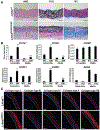Disrupting the LINC complex in smooth muscle cells reduces aortic disease in a mouse model of Hutchinson-Gilford progeria syndrome
- PMID: 30257952
- PMCID: PMC6166472
- DOI: 10.1126/scitranslmed.aat7163
Disrupting the LINC complex in smooth muscle cells reduces aortic disease in a mouse model of Hutchinson-Gilford progeria syndrome
Abstract
Hutchinson-Gilford progeria syndrome is a disorder of premature aging in children caused by de novo mutations in LMNA that lead to the synthesis of an internally truncated form of prelamin A (commonly called progerin). The production of progerin causes multiple disease phenotypes, including an unusual vascular phenotype characterized by the loss of smooth muscle cells in the arterial media and fibrosis of the adventitia. We show that progerin expression, combined with mechanical stress, promotes smooth muscle cell death. Disrupting the linker of the nucleoskeleton and cytoskeleton (LINC) complex in smooth muscle cells ameliorates the toxic effects of progerin on smooth muscle cells and limits the accompanying adventitial fibrosis.
Copyright © 2018 The Authors, some rights reserved; exclusive licensee American Association for the Advancement of Science. No claim to original U.S. Government Works.
Conflict of interest statement
Figures






Similar articles
-
Cardiovascular Progerin Suppression and Lamin A Restoration Rescue Hutchinson-Gilford Progeria Syndrome.Circulation. 2021 Nov 30;144(22):1777-1794. doi: 10.1161/CIRCULATIONAHA.121.055313. Epub 2021 Oct 25. Circulation. 2021. PMID: 34694158 Free PMC article.
-
The accumulation of progerin underlies the loss of aortic smooth muscle cells in Hutchinson-Gilford progeria syndrome.Cell Death Dis. 2025 Jul 24;16(1):557. doi: 10.1038/s41419-025-07853-0. Cell Death Dis. 2025. PMID: 40707465 Free PMC article.
-
Vascular Smooth Muscle-Specific Progerin Expression Accelerates Atherosclerosis and Death in a Mouse Model of Hutchinson-Gilford Progeria Syndrome.Circulation. 2018 Jul 17;138(3):266-282. doi: 10.1161/CIRCULATIONAHA.117.030856. Epub 2018 Feb 28. Circulation. 2018. PMID: 29490993 Free PMC article.
-
Vascular smooth muscle cell loss underpins the accelerated atherosclerosis in Hutchinson-Gilford progeria syndrome.Nucleus. 2019 Dec;10(1):28-34. doi: 10.1080/19491034.2019.1589359. Nucleus. 2019. PMID: 30900948 Free PMC article. Review.
-
Hutchinson-Gilford progeria syndrome through the lens of transcription.Aging Cell. 2013 Aug;12(4):533-43. doi: 10.1111/acel.12070. Epub 2013 Apr 19. Aging Cell. 2013. PMID: 23496208 Review.
Cited by
-
The Nuclear Lamina: Protein Accumulation and Disease.Biomedicines. 2020 Jul 1;8(7):188. doi: 10.3390/biomedicines8070188. Biomedicines. 2020. PMID: 32630170 Free PMC article. Review.
-
A network of nuclear envelope proteins and cytoskeletal force generators mediates movements of and within nuclei throughout Caenorhabditis elegans development.Exp Biol Med (Maywood). 2019 Nov;244(15):1323-1332. doi: 10.1177/1535370219871965. Epub 2019 Sep 7. Exp Biol Med (Maywood). 2019. PMID: 31495194 Free PMC article. Review.
-
Lamin A/C Mechanotransduction in Laminopathies.Cells. 2020 May 24;9(5):1306. doi: 10.3390/cells9051306. Cells. 2020. PMID: 32456328 Free PMC article. Review.
-
Revisiting the truncated lamin A produced by a commonly used strain of Lmna knockout mice.Nucleus. 2023 Dec;14(1):2262308. doi: 10.1080/19491034.2023.2262308. Epub 2023 Sep 27. Nucleus. 2023. PMID: 37754663 Free PMC article.
-
Increased expression of LAP2β eliminates nuclear membrane ruptures in nuclear lamin-deficient neurons and fibroblasts.Proc Natl Acad Sci U S A. 2021 Jun 22;118(25):e2107770118. doi: 10.1073/pnas.2107770118. Proc Natl Acad Sci U S A. 2021. PMID: 34161290 Free PMC article.
References
-
- DeBusk FL, The Hutchinson-Gilford progeria syndrome. Report of 4 cases and review of the literature. J. Pediatrics 80, 697–724 (1972). - PubMed
-
- Eriksson M, Brown WT, Gordon LB, Glynn MW, Singer J, Scott L, Erdos MR, Robbins CM, Moses TY, Berglund P, Dutra A, Pak E, Durkin S, Csoka AB, Boehnke M, Glover TW, Collins FS, Recurrent de novo point mutations in lamin A cause Hutchinson-Gilford progeria syndrome. Nature 423, 293–298 (2003). - PMC - PubMed
-
- Kieran MW, Gordon L, Kleinman M, New approaches to progeria. Pediatrics 120, 834–841 (2007). - PubMed
-
- Gordon LB, McCarten KM, Giobbie-Hurder A, Machan JT, Campbell SE, Berns SD, Kieran MW, Disease progression in Hutchinson-Gilford progeria syndrome: impact on growth and development. Pediatrics 120, 824–833 (2007). - PubMed
Publication types
MeSH terms
Substances
Grants and funding
LinkOut - more resources
Full Text Sources
Other Literature Sources
Molecular Biology Databases
Miscellaneous

